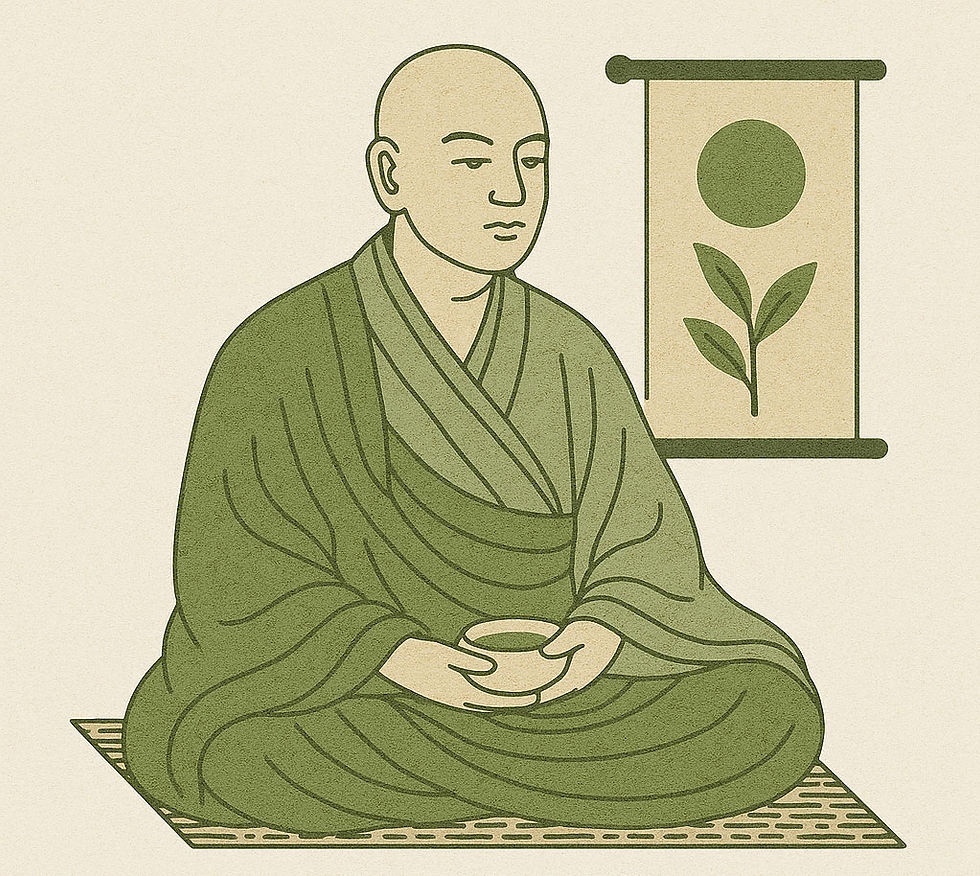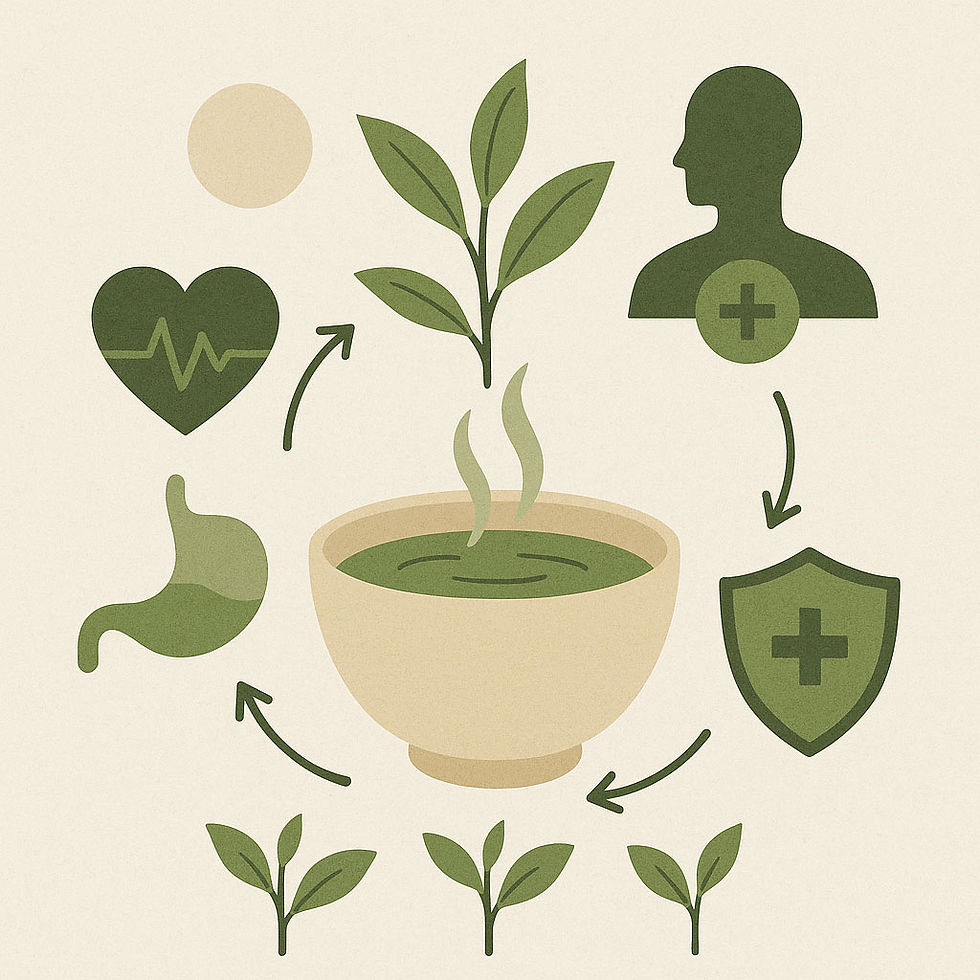Matcha: The Elegance of a Leaf, Reflection of a Thousand-Year-Old Tradition
- Devrim Karagoz
- Apr 17
- 5 min read
Matcha, which has been rediscovered by tea lovers around the world in recent years, is not just a drink; it is a life practice that symbolizes Japanese aesthetics, Zen philosophy and patience. Behind this elegant powdered green tea, which has reached from ancient times to modern cuisines; philosophy, agricultural art and a deep ritual are hidden.
What is Matcha? Is it just powdered green tea?
Matcha is a green tea in powder form, obtained by growing the youngest leaves of the Camellia sinensis plant with certain shading techniques, separating them from their veins and stems, and then grinding them finely in traditional stone mills. But this definition does not suffice to describe its essence.
Unlike traditional green teas, which are brewed, when you drink matcha, you consume not just the leaf extract but the entirety of the leaf itself. This sets it apart from all other teas in terms of both nutritional content and experience. Every sip is a moment when you invite the full essence of nature into your body.

Origins: From Chinese Monasteries to Japanese Temples
Tracing matcha takes us back to 9th century Tang Dynasty China, when tea leaves were steamed, crushed on a stone to make a powder, and mixed with hot water to consume. This method was common among Chinese Zen monks to clear the mind before meditation.
In the 12th century, the Japanese Zen priest Eisai brought this practice from China to Japan. However, in Japan, this tea gradually became not just a beverage but a cornerstone of the tea ceremony (Chanoyu). Here, tea preparation is a spiritual practice integrated with awareness, simplicity and aesthetics.
At the core of this ritual lies the Zen philosophy. Preparing and drinking matcha is not just consuming a beverage, but a journey of living the moment with all senses, accepting the transience of nature and reaching spiritual serenity. Time slows down with the flow of the tea, and inner awareness deepens.

Agricultural Elegance:
Matcha's Production Process
Matcha production is a rare example of the perfect collaboration between nature and man. Each step requires patience, attention and technical mastery.
1. Shadowing (Tana or Kabuse methods)
About 3 weeks before harvest, the tea plants are covered to block out direct sunlight. This increases the chlorophyll level, giving the leaves a more intense umami taste, and increases amino acids such as L-theanine. The leaves turn a darker, brighter green during this process.
2. Hand Harvesting
This harvest, which only takes place during a certain period of the year, in early spring and mostly in the cool hours of the morning, focuses on the youngest and most tender upper leaves. Mechanical harvesting is unacceptable for ceremonial quality. Each leaf is picked individually by hand.
3. Steaming and Drying
The collected leaves are steamed for a short time to prevent oxidation. This process preserves the color and freshness of the leaves. The dried leaves are then rested and stacked.
4. Tencha Preparation
After the leaves are dried, they are carefully separated from the veins and stems. The remaining leaf tissue is called “tencha” and is used exclusively in the production of matcha. Tencha is the essence of matcha with its fine and pure texture.
5. Grinding with Stone Mill
Tencha is ground slowly in granite stone mills. Only 30–40 grams of matcha are produced per minute. This process requires skill and patience, as rapid grinding can destroy the flavor and nutritional value due to frictional heat. This grinding process ensures that the matcha is powder-fine and silky in texture.

Health Effects: Modern Interpretation of Ancient Knowledge
Matcha is not only a tradition, but also a scientifically supported superfood:
High Antioxidant Power: Matcha is especially rich in a compound called EGCG. It neutralizes the effects of free radicals and slows down cellular aging.
Balance of L-theanine & Caffeine: Rather than creating an immediate arousal like in coffee, the caffeine in matcha works in synergy with L-theanine to provide long-lasting focus and mental clarity.
Metabolism & Detox: Matcha supports the liver, facilitates the elimination of toxins, stimulates digestion and energy metabolism.
Spiritual Effect: It’s no coincidence that Zen monks drink matcha before meditation. It gently stimulates the body while calming the mind—literally, “wakeful peace.”
How to Identify Matcha Quality?
When buying matcha, the content should speak for itself, not the packaging. A truly ceremonial quality matcha should have the following characteristics:
At Mama Ram, we source our matcha from the Uji region of Japan, from tea masters who adhere to traditional shaving and stone grinding techniques.
In Every Area of Life with Matcha
Today, matcha finds its place in a wide spectrum, from luxurious tea ceremonies to wellness cuisines, from minimalist Japanese tables to Instagram aesthetics.
Matcha Latte – A slightly sweet, slightly earthy, foamy morning delight
Matcha Desserts – Adds character to recipes from cheesecake to brownies
Smoothie Bowl / Energy Balls – Perfect for an energetic start, full of antioxidants
Ice creams, macaroons, morning pancakes… – Matcha is no longer just a tea, it is a colorful player in contemporary cuisine

Mini Ritual: Clear Your Mind While Making Matcha
Matcha is not just a drink, it is also a mindfulness practice. Making it means slowing down time for a few minutes and coming back to yourself. Here are the steps to making that moment sacred:
Required Items:
1 teaspoon ceremonial grade matcha
60-70 ml hot water (75-80°C)
Bamboo whisk (chasen)
Matcha bowl (chawan)
Fine sieve (to gently sift the matcha)
Preparation Steps:
Take a sip and breathe in: Sift the matcha into a bowl. This step helps prevent clumping and adds lightness to the drink. Take a deep breath in at the same time — this is the first contact between you and the tea.
Listen to the sound of water: After the water boils, wait a few minutes; it should reach 75-80°C. In the meantime, hold the bowl with both hands and prepare for the moment when the ceremony will begin.
The art of whisking: Pour water over matcha. Using a bamboo whisk, make an “M” or “W” shape and whisk rhythmically. When bubbles form, you feel the drink “come alive.”
First sip: Every sip is like a connection to nature, the past, and the present. It is traditional to serve it with a sweet accompaniment (such as a small wagashi or plain mochi), but drinking it plain is also a deeply soothing and profound experience.
If you want a modern twist, you can use this base to make a matcha latte by adding milk. But remember, plain matcha has a unique depth.
This little ritual is like a moment of silence in the middle of the day, an inviting doorway to begin again, time and time again.
The Rise of Matcha in the West: Meaning Beyond Trend
In the twenty-first century, matcha has moved from the mysterious tea ceremonies of the Far East to the center of global wellness culture. Especially prominent on social media with its aesthetic presentations and health benefits, matcha is no longer just a "trend" but a symbol of conscious consumers.
In the US and Europe, baristas are putting aside the classic espresso and making matcha shots, while nutritionists are also recommending it as part of their morning rituals. But to understand matcha is not just to see it as a superfood; it is to realize that it is also a carrier of ancient wisdom. Against the fast pace of modern life, drinking a cup of matcha is an invitation to slow down, to be mindful, to be grounded.
Meet Mama Ram Matcha
At Mama Ram, we offer you unadulterated, ceremonial quality matcha from Japan's most respected producing regions. This is not just a product; it's an experience that brings the elegance of Eastern philosophy to your kitchen.



Comments